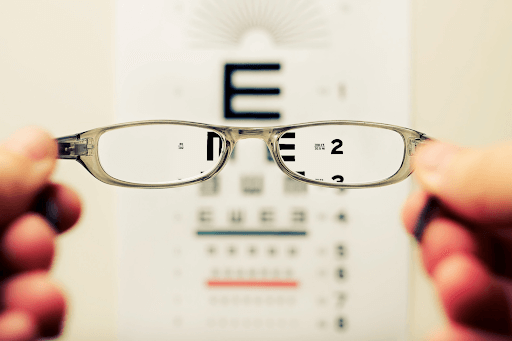According to the American Academy of Ophthalmology, astigmatism is a widespread refractive error that affects roughly one in three people. With such a significant portion of the population impacted by astigmatism, the need for reliable and effective treatment options like LASIK for astigmatism becomes increasingly crucial.
Refractive errors encompass a range of eye conditions influencing how light bends or refracts as it enters the eye. Astigmatism is a prevalent refractive error that can coexist with nearsightedness (myopia) or farsightedness (hyperopia) and often presents from birth due to the eye’s shape. The primary cause of astigmatism is usually an irregularly shaped cornea, known as corneal astigmatism. However, it can also result from the crystalline lens inside the eye, termed lenticular astigmatism.
In cases of corneal astigmatism, the cornea’s curvature is not uniformly spherical. Instead, its contour resembles a football rather than a perfectly round basketball or soccer ball. Similarly, with lenticular astigmatism, the lens exhibits an uneven shape. An unevenly shaped lens can cause light to scatter unevenly onto the retina, leading to distorted vision. This can result in difficulty seeing near and far objects and may even cause headaches or eye strain.
When the cornea or lens is asymmetrical, light entering the eye splits and forms two distinct focal points – causing visual distortion and blurriness. Depending on whether the patient also has myopia or hyperopia, these focal points land in front of (myopia) or behind (hyperopia) the retina—the light-sensitive tissue at the back of the eye. Consequently, individuals with astigmatism experience blurred vision due to the incorrect focusing of light.
Technological advances have made LASIK for astigmatism a highly effective and sought-after solution. Addressing frequently asked questions and providing valuable information from authoritative sources enables those with astigmatism to make educated decisions about their eye health. If you’re ready to take the next step towards clearer vision, schedule a LASIK Exam Today!
FAQs about LASIK for Astigmatism
Understanding LASIK for astigmatism is crucial for those seeking clearer vision without needing glasses or contact lenses. In this section, we will address the most frequently asked questions about LASIK for astigmatism, exploring candidate eligibility, the LASIK procedure, risks and benefits, costs and insurance, and other treatment options.
Candidate Eligibility
Understanding the qualifications and requirements for LASIK candidacy is the first step toward achieving optimal vision correction. So, what factors determine eligibility for LASIK for astigmatism?
-
Who is a good candidate for LASIK for astigmatism?
A good candidate for LASIK for astigmatism is someone with a stable prescription, healthy corneas, and no other eye conditions that may complicate the procedure. At Saddleback Eye Center, we prioritize safety and accuracy above all else, which is why Dr. Manger personally conducts a comprehensive 14-test diagnostic examination for each LASIK candidate. This in-depth, 2½-hour evaluation allows Dr. Manger to gain a thorough understanding of each patient’s unique eye health, to determine which treatment is the right choice for them.
During the examination, Dr. Manger assesses various aspects of the patient’s eyes, such as prescription stability, corneal health, and the absence of other eye conditions that might complicate the LASIK procedure. This meticulous approach helps us determine who is a good candidate for LASIK for astigmatism while minimizing potential risks.
As a respected and experienced eye surgeon, Dr. Manger believes in providing the utmost level of care to each patient. By performing the 14-test diagnostic examination, Dr. Manger can address any concerns or questions about LASIK, ensuring you feel confident in the procedure.
-
Are there any age restrictions for LASIK?
While there isn’t a strict age limit for LASIK, most surgeons recommend that patients be at least 18 to ensure their prescription has stabilized. This is important because the eye’s prescription can change significantly during adolescence. Additionally, older patients may experience age-related eye changes, such as the development of cataracts or presbyopia, that could affect their eligibility for LASIK or postoperative visual outcomes.
-
Can LASIK be performed on both eyes at the same time?
Yes, LASIK can be performed on both eyes during the same procedure, known as bilateral simultaneous LASIK. This approach offers several advantages, such as a quicker recovery, faster visual improvement, and increased patient convenience.
-
What medical conditions would disqualify a person from getting LASIK for astigmatism?
Certain medical conditions, such as uncontrolled diabetes, autoimmune diseases (e.g., lupus or rheumatoid arthritis), immunodeficiency disorders, or a history of corneal disease (e.g., keratoconus), could disqualify someone from undergoing LASIK.
Your eye doctor will evaluate your overall health, including any medications you may be taking, to determine if you’re a suitable candidate for the procedure.
LASIK Procedure
The LASIK procedure for astigmatism is an effective and efficient method for correcting this refractive error, offering patients improved vision and reduced or eliminated dependence on glasses or contact lenses. During the procedure, a highly precise laser is used to reshape the cornea, addressing the irregular curvature that causes astigmatism.
The process begins with creating a thin corneal flap, which is gently lifted to expose the underlying corneal tissue. The laser then removes a small amount of tissue, sculpting a more regular corneal shape that allows light to focus accurately on the retina. The flap is then repositioned and adheres naturally without the need for stitches.
-
How does LASIK correct astigmatism?
LASIK corrects astigmatism by reshaping the eye’s cornea, the transparent outer surface. By using a precise laser, the surgeon removes a small amount of corneal tissue, creating a more regular shape that allows light to focus correctly on the retina, resulting in clearer vision.
-
How long does the LASIK procedure take?
The actual LASIK procedure typically takes just a few minutes per eye. Most patients spend about 15 to 30 minutes in the treatment room.
-
Is LASIK for astigmatism painful?
LASIK for astigmatism is not painful. Your surgeon will use numbing eye drops to ensure comfort during the procedure. Some patients may experience mild discomfort or a feeling of pressure during the surgery, but this is temporary and resolves quickly.
-
What is the recovery time after LASIK for astigmatism?
The recovery time after LASIK for astigmatism is relatively short. Most patients notice an improvement in their vision within a day, and complete recovery usually occurs within a few weeks. Your eye doctor will provide specific recovery instructions and a follow-up appointment schedule to monitor your progress.
Risks and Benefits
According to the American Refractive Surgery Council, the risk of experiencing a severe complication from LASIK is less than 1%. This means that the vast majority of patients who undergo LASIK for astigmatism can enjoy the benefits of improved vision with minimal risks.
-
What are the potential risks and complications of LASIK for astigmatism?
As with any surgical procedure, LASIK for astigmatism carries some risks. Potential complications include infection, dry eye syndrome, and under- or over-correction. However, these risks are generally low, and most patients experience successful outcomes with minimal side effects.
-
Is LASIK for astigmatism permanent?
In most cases, LASIK for astigmatism provides permanent vision improvement. However, some patients may experience age-related vision changes, such as presbyopia, which may require additional treatment or corrective lenses in the future.
-
What are the benefits of LASIK for astigmatism?
The benefits of LASIK for astigmatism include improved vision without the need for glasses or contact lenses, a quick recovery time, and a high success rate. Many patients experience a significant enhancement in their quality of life after undergoing LASIK.
Cost and Insurance
Understandably, the cost is often a significant consideration of medical procedures, and LASIK for astigmatism is no different. While the price of LASIK can vary depending on several factors, there are ways to make the procedure more affordable. Let’s take a closer look at the costs and insurance options for LASIK for astigmatism.
-
How much does LASIK for astigmatism cost?
The cost of LASIK for astigmatism can vary depending on factors such as the surgeon’s experience, the technology used, and the clinic’s location. The average price ranges from $2,000 to $3,500 per eye.
At Saddleback Eye Center, we strive to make LASIK accessible, considering the amount spent on glasses, contact lenses, and solutions over an 8 to 10-year period. We offer various payment options and financing plans to help make LASIK affordable, so you don’t have to wait to enjoy improved vision.
-
Does insurance cover the cost of LASIK for astigmatism?
Insurance coverage for LASIK can vary. Many insurance plans consider LASIK a cosmetic procedure and do not cover it. However, some plans may offer partial coverage or discounts. It’s crucial to consult your insurance provider to understand your coverage options and any potential out-of-pocket expenses.
At Saddleback Eye Center, we accept several forms of payment, including CareCredit Financing, Alphaeon Financing, cash, personal checks, and major credit cards. We also offer no-interest and low-interest financing options through our financing partners on approved credit. Our team is happy to help you set up a payment plan that suits your budget and assist with the paperwork. The approval process is quick and straightforward.
Now that we’ve covered some of the most common FAQs about LASIK for astigmatism, you should have a clearer understanding of this popular vision correction procedure. It’s important to remember that each patient’s situation is unique. The best way to determine if LASIK for astigmatism is right for you is to consult a qualified eye care professional.
If you’re interested in pursuing LASIK for astigmatism, don’t hesitate to schedule a consultation with renowned LASIK expert Dr. Manger for any additional questions!
LASIK For Astigmatism
In conclusion, understanding the essential aspects of LASIK for astigmatism, such as candidate eligibility, the procedure itself, risks and benefits, costs and insurance, is crucial for making an informed decision about your vision correction. LASIK offers several advantages over other treatments, including permanent vision improvement, fast recovery time, and minimal complications, making it a preferred choice for many patients.
It’s important to remember that each individual’s situation varies. The best way to determine if LASIK for astigmatism is right for you is to consult a qualified LASIK surgeon. The expert team at Saddleback Eye Center, led by renowned LASIK specialist Dr. Manger, is here to answer any additional questions and help guide you through the decision-making process.
Don’t hesitate to take the first step toward clearer vision – contact Saddleback Eye Center today to learn more about LASIK for astigmatism!



